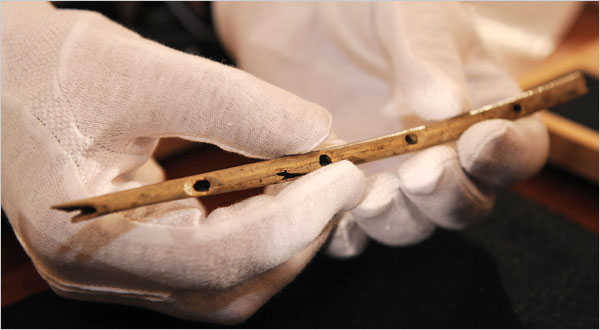Music has been an integral part of human culture since time immemorial. From the rhythmic beats of primitive drums to the intricate melodies of orchestras, music has evolved and shaped our societies. But have you ever wondered about the origins of music? In this blog, we delve into the fascinating story of the Hohle Fels Flute, the oldest known musical instrument ever discovered, and explore its significance in understanding the early expressions of music in human history.
Discovery of the Hohle Fels Flute:
The Hohle Fels Flute was found in the Hohle Fels cave, located in the Swabian Jura region of Germany. In 2008, a team of archaeologists led by Professor Nicholas Conard unearthed this remarkable artifact. The flute was crafted from the hollow wing bone of a griffon vulture, carefully carved and intricately perforated with five finger holes.

Dating the Flute:
Through meticulous scientific analysis, including radiocarbon dating and stratigraphic examination, researchers determined that the Hohle Fels Flute is approximately 40,000 years old. This places its creation in the Upper Paleolithic era, known as the Aurignacian period, making it a testament to the musical creativity of early humans.
Statistics about Hohle Fels Flute:
| Attribute | Value |
|---|---|
| Age | Approximately 40,000 years |
| Discovery Location | Hohle Fels Cave, Swabian Jura, Germany |
| Material | Griffon vulture wing bone |
| Number of Finger Holes | 5 |
| Cultural Period | Upper Paleolithic (Aurignacian) |
| Significance | Oldest known musical instrument |
| Preservation Status | Replica created from surviving fragments |
| Research Contributions | Understanding prehistoric music and human culture |
Musical Expression in Prehistoric Times:
The existence of the Hohle Fels Flute sheds light on the cultural and artistic capabilities of our ancestors. It suggests that music played an important role in their lives, serving as a means of expression, communication, and perhaps even spiritual rituals. The flute's intricate design and the precision required to create it highlight the advanced cognitive abilities and artistic sensibilities of our early human predecessors.
Uncovering the Melodies of the Past:
While the organic materials used in the construction of the Hohle Fels Flute have long since deteriorated, researchers have been able to reconstruct the instrument based on its surviving fragments. By studying the replica flutes and experimenting with different playing techniques, musicians and archaeologists have attempted to recreate the sounds that would have resonated through ancient caves thousands of years ago.
Significance and Legacy:
The Hohle Fels Flute holds immense significance in our understanding of human history and the evolution of music. It represents an early form of musical expression, showcasing the universal human impulse to create and appreciate beauty through sound. This ancient instrument bridges the gap between our distant ancestors and modern musicians, providing a tangible connection to our shared musical heritage.
Preservation and Future Discoveries:
The discovery of the Hohle Fels Flute has sparked further interest in uncovering other ancient musical artifacts. Archaeologists continue to explore caves, burial sites, and ancient settlements, hoping to unearth additional evidence of early musical instruments and expand our knowledge of prehistoric musical traditions.
Conclusion: The Hohle Fels Flute stands as a testament to the creativity and cultural significance of music in the human experience. Its discovery offers a glimpse into the rich musical traditions that have accompanied our species for tens of thousands of years. As we contemplate the melodies produced by this ancient instrument, we gain a deeper appreciation for the power of music to connect us across time and celebrate the enduring legacy of human creativity.
Discover More
Most Viewed
Christmas is a season of joy, love, and traditions. And what better way to get into the holiday spirit than through timeless carols? These musical gems have been bringing people together for generations. Here’s our ranked list of the Top 10 Christmas Caro…
Read More















